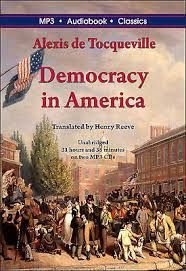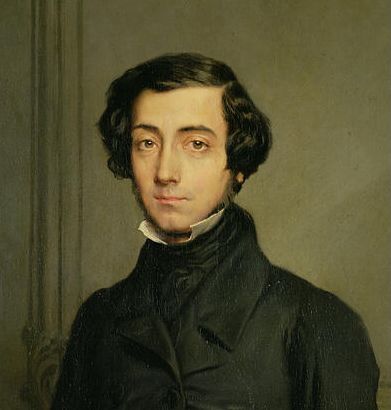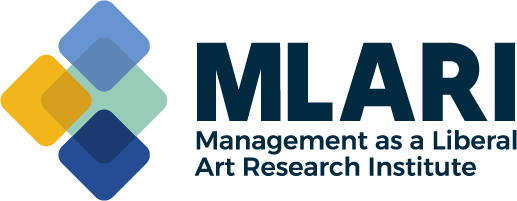
One can use Drucker’s ideas to understand the political and social scene in China today. Let’s start with a story. Fyodor Dostoyevsky published his novel The House of the Dead in 1862. Dostoyevsky actually spent time in a Siberian prison camp, and drew on that experience as he depicted prisoners in the novel. These prisoners were seen as hardened criminals, and go through an incredible transformation at Christmastime. They are permitted to put on a play. Suddenly, these hardened criminals are bursting with creativity. They’re writing, directing, designing costumes, an entire production process involved in creating this theatrical play. A completely different side of them comes out. This story illustrates a point that is at the heart of Drucker’s work. This is the idea that no system, no matter how restrictive or oppressive, can completely destroy our humanity. Even within a place as terrible as a prison, there is still room for agency, for choosing how we respond to our circumstances. Even with limitations, they found a way to express themselves. The prisoners find a way to carve out a space for freedom. It makes one think about those times when we are boxed in by expectations, or stuck in a rut. Maybe there is always a way to break out. This ties in perfectly with what Drucker always talked about in terms of individual responsibility. It’s not about waiting for someone to give you permission, or for the perfect situation to magically appear. It’s about realizing that we always have choices, and those choices make us who we are. So these prisoners are finding freedom in this highly unlikely place! But we can see how this links to Drucker’s thoughts on societal order. Think about it: Are we all prisoners in some way? This is where Drucker’s own experiences in 20 th -century Europe become incredibly relevant to our own lived experience today. He saw the rise of totalitarian regimes firsthand. He likened them to “beehives” and “anthills” where individual freedom was crushed by the weight of the state. Like everyone is marching in line; there is no room for being different. Let us think about this: even in societies that aren’t explicitly totalitarian, we can still build those same kinds of structures: prisons of conformity and control, where everyone is expected to be the same. Drucker saw this as the complete opposite of the chaos of disorder. A healthy society has to find that balance. You need a middle ground of diversity, this multi-layered system where individuals can find meaning without being crushed by a large, powerful authority. Walking a tightrope between too much order and too much chaos. Too much order represents the beehive model. Too much chaos creates the jungle, where it is everyone for himself. Finding the middle ground is a challenge. It’s the balance between individual freedom, and a sense of order. In many ways, Chinese society places value on order and control. But Drucker’s ideas about personal responsibility and gives one a choice to exercise individual freedom even within a system of constraints. How do we find those little spaces for freedom within those constraints? You can’t change the system, but you can make choices that allow you to exercise your own agency, and align your actions with your beliefs. That brings us to one of Drucker’s most mind-blowing ideas: it’s what he called the “mechanistic world view.” He thought that seeing the world as a giant machine with humans as cogs in the system disrupts how we see the concepts of freedom and responsibility. Imagine a factory with an assembly line, where each worker has their one specific job. They do this over and over again, with no room for creativity, no sense of ownership. That’s the essence of the mechanistic world view: we all become robots, following a program. Freedom, in this word view, becomes chasing simple pleasures, like comfort. There is no sense of purpose. One just goes through the motions. The focus is on efficiency and output, not the human factors that go into work. Responsibility is reduced to following orders rather than making thoughtful choices. If the mechanistic world view is the problem, what is the alternative? Drucker gives us an alternative: the teleological world view. This is the view that the universe is not a static machine, but rather a dynamic system where everything is connected from atoms to humans. Everything contributes to create a new order. In this world view, freedom isn’t doing what you feel like, or feels good, but developing your potential as a human being and using that to contribute to something bigger than yourself. Responsibility isn’t about following rules, but understanding the impact your choices have. Thinking back to the prisoner story we began with: their decisions had impacts. They tapped into their potential, and found a shared purpose. This resonates with Eastern Philosophical ideas of individual cultivation and harmony with the cosmos. Drucker’s ideas, while grounded in Western traditions, transcend cultural boundaries. How much of our lives, regardless of culture, are actually run by this mechanistic mindset? In work, school – are we really encouraged to think for ourselves? Or to contribute to some bigger purpose? Even in systems that feel very mechanistic, there will always be ways to find pockets to express freedom – places where we can make a choice and do something meaningful. It may not be easy, but it is always there. It starts with recognizing that we have a choice. We can be cogs in the machine. Or we can choose to be creative agents of change. We are reminded of where we began, with Dostoyevsky, who said “man is created for freedom.” Even when things are difficult, we are hardwired for expressing ourselves and deciding our own path. It’s all about finding those stages within the prison walls. The limitations exist in Chinese society; but that doesn’t mean that we can’t have a free existence. Drucker’s ideas, while Western, have resonance in other cultures. Freedom is not just a large, abstract concept. It’s also about the everyday choices we make within our specific cultural contexts. The little ways we express ourselves and choose to build something new instead of accepting the status quo. Making things more beautiful and meaningful, even if it’s just in our own small world. Which brings us back to Drucker’s definition of freedom. For him, freedom involved responsible choice. It is not right as much as responsibility. It is not something given to us. It’s something we must work for and earn. And we choose it every day through our actions. One final thought: If life is a stage, what role would you play? What kind of performance are you giving to the world? Are you building prisons? Or are you building stages? Are you choosing freedom and responsibility? Or are you just going through the motions? This is not about easy answers. It’s about finding a world where freedom and responsibility can coexist and thrive.
Popular Stories

Throughout my career, I’ve been fortunate to work in several great organizations. I’ve had great managers who have shared their wisdom and taught me important skills. However, there was one organization where things were different – It was a reputable organization where top-down management reigned and where power was abused to keep employees from questioning decisions. Ultimately, this organization struggled to achieve what renowned psychologist, Dr. Mihaly Robert Csikszentmihalyi, would call ‘flow’. According to Csikszentmihalyi, ‘flow’ is a state of consciousness where people experience deep enjoyment, creativity, and a total involvement in an activity where nothing else seems to matter. Csikszentmihalyi argued that organizations could foster an environment conducive to a positive state of flow where individuals could enjoy their work, become highly engaged, and therefore, become more productive and committed to the organization’s mission. Yet, this particular organization ignored the importance of fostering an environment where people could find enjoyment and engagement. Instead, upper management made decisions without promoting dialogue and discussion. We felt as if a decision had already been made prior to the meeting, and we simply needed to agree with upper management when the idea was presented. Over time, people became increasingly silent in meetings. Managers became more impatient with those few who would ask a question. Ultimately, the fear of being publicly shamed, ridiculed, or verbally insulted by management led to ‘groupthink’. Originally coined by psychologist, Irving Janis, ‘groupthink’ is the process in which a team conforms to a leader’s opinion and has little tolerance for divergent opinions. In this organization, upper management moved forward with its decisions, and hired people who followed along and agreed with the prevailing views of upper management. As upper management continued to develop the strategic plan, they did not realize that they were missing key data and viewpoints. Rather, upper management relied on their assumptions and their own perceptions, rather than seeking to gather evidence and challenging opinions. Hence, their decisions became quite often inundated with incongruities, which resulted in flawed decision processes and poor performance. As the weeks transpired, three key indicators began to signal that the organization was in trouble. The employee turnover rate increased. Sales decreased. And customer retention decreased. To make matters worse, employee morale dropped. Although the data revealed that something was amiss, upper management decided to keep course and maintain processes as they were. Over time, remaining employees grew afraid of losing their jobs. The organization was inundated with opinion conformity. This prevented employees from ever learning and developing critical thinking skills. Upper management began to argue that the company was experiencing “temporary” challenges which were caused by market and economic forces. However, interestingly, while this organization was declining, competitors were experiencing growth and increasing sales. Ultimately, the organization became saturated with inflexibility and risk aversion. Several employees (including me) left the organization dissatisfied with the culture and frustrated about not being able to grow and contribute. The organization relied on the wisdom and experience of its upper management, but did not realize that the environment around them kept changing, and hence they should be flexible and open to new ideas. The organization failed to appreciate its employees and the ideas they could have contributed. Instead of encouraging employees to speak up and share, they shut them down. Upper management should have focused on building people, motivating them to contribute, and allowing them to become engaged with the mission. Employees should have been encouraged to build on their skills and use divergent thinking in decision-making. Encouraging the establishment of an innovative and creative environment can yield substantially powerful and transformational effects on any organization, while providing individuals with high-challenge, high-skill situations that will increase flow and performance. References: Csikszentmihalyi, Mihaly. Flow: The psychology of optimal experience. New York: Harper & Row, 1990. Janis, Irving L. "Groupthink and group dynamics: A social psychological analysis of defective policy decisions." Policy Studies Journal 2.1 (1973): 19.

Peter Drucker suggested that readers view his first three books as a unified body of work: The End of Economic Man(1939), The Future of Industrial Man (1942), and Concept of the Corporation (1946). These works share a common theme: politics. Drucker did not think about politics like scholars who strictly follow modern social science norms. Instead, he viewed politics as part of social ecology and understood political events through the dynamic changes in social ecology. Despite having "corporation" in its title and using General Motors as a case study, Concept of the Corporation is indeed a book about politics. In this work, Drucker attempts to address the main issues that industrial society must resolve: the legitimacy of managerial authority, the status and function of managers and workers, and the power structure of society and organizations. In Drucker's own words, this is a book exploring the specific principles of industrial society. Corresponding to these specific social principles, Drucker had earlier attempted to develop a general social theory, which was the aim of The End of Economic Man and The Future of Industrial Man. The subtitle of The End of Economic Man is "The Origins of Totalitarianism." The book focuses on how society disintegrates in industrial societies and how totalitarianism rises. For Drucker, the real challenge of this topic isn't explaining how Hitler and Mussolini came to power, nor the actions of Germany and Italy in government, military, and economic spheres. Rather, it's understanding why some Europeans accepted clearly absurd totalitarian ideologies, and why others seemed potentially receptive to them. Drucker's writing style is argumentative. He clearly knew that to effectively advance his arguments, he needed to engage with popular theories of his time. Back then, there were two main explanatory approaches to Nazism and Fascism, which Drucker termed "illusions." Some viewed totalitarianism as ordinary political turmoil similar to previous historical revolutions. In their view, totalitarianism was characterized merely by cruelty, disruption of order, propaganda, and manipulation. Others considered totalitarianism a phenomenon unique to Germany and Italy, related to their specific national characters. Drucker thoroughly refuted explanations based on "national character." He believed that any historical approach appealing to "national character" was pseudo-history. Such theories always emphasize that certain events were inevitable in certain places. But all claims of "inevitability" negate human free will and thus deny politics: without human choice, there is no politics. If the rise of totalitarianism were inevitable, there would be no need or possibility to oppose it. Viewing totalitarianism as an ordinary revolution is equally dangerous. This thinking merely emphasizes how bad Nazis and Fascists were. But the real issue is that Europeans were not merely submitting out of fear—they were actually attracted to totalitarianism. And those attracted weren't just the ignorant masses but also well-educated intellectual elites, especially the younger generation. The world cannot defeat totalitarianism through contempt alone, especially if that contempt stems from ignorance. Understanding the enemy is a prerequisite to defeating it. Drucker identified three main characteristics of Nazism and Fascism (totalitarianism is a social type, with Nazism and Fascism being its representatives in industrialized Europe): 1. The complete rejection of freedom and equality, which are the core beliefs of European civilization, without offering any positive alternative beliefs. 2. The complete rejection of the promise of legitimate power. Power must have legitimacy—this is a long-standing tradition in European politics. For power to have legitimacy means that it makes a commitment to the fundamental beliefs of civilization. Totalitarianism denied all European beliefs, thereby liberating power from the burden of responsibility. 3. The discovery and exploitation of mass psychology: in times of absolute despair, the more absurd something is, the more people are willing to believe it. The End of Economic Man develops a diagnosis of totalitarianism around these three characteristics. Drucker offers a deeper insight: totalitarianism is actually a solution to many chronic problems in industrial society. At a time when European industrial society was on the verge of collapse, totalitarians at least identified the problems and offered some solutions. This is why they possessed such magical appeal. Why did totalitarianism completely reject the basic beliefs of European civilization? Drucker's answer: neither traditional capitalism nor Marxist socialism could fulfill their promises of freedom and equality. "Economic Man" in Drucker's book has a different meaning than in Adam Smith's work. "Economic Man" refers to people living in capitalist or socialist societies who believe that through economic progress, a free and equal world would "automatically" emerge. The reality was that capitalism's economic freedom exacerbated social inequality, while socialism not only failed to eliminate inequality but created an even more rigid privileged class. Since neither capitalism nor socialism could "automatically" realize freedom and equality, Europeans lost faith in both systems. Simultaneously, they lost faith in freedom and equality themselves. Throughout European history, people sought freedom and equality in different social domains. In the 19th century, people projected their pursuit of freedom and equality onto the economic sphere. The industrial realities of the 20th century, along with the Great Depression and war, shattered these hopes. People didn't know where else to look for freedom and equality. The emerging totalitarianism offered a subversive answer: freedom and equality aren't worth pursuing; race and the leader are the true beliefs. Why did totalitarianism reject the promise of power legitimacy? One reason was that political power abandoned its responsibility to European core beliefs. Another reason came from the new realities of industrial society. Drucker held a lifelong view: the key distinction between industrial society and 19th-century commercial society was the separation of ownership and management. The role of capitalists was no longer important. Those who truly dominated the social industrial sphere were corporate managers and executives. These people effectively held decisive power but had not gained political and social status matching their power. When a class's power and political status don't match, it doesn't know how to properly use its power. Drucker believed this was a problem all industrial societies must solve. Totalitarianism keenly perceived this issue. The Nazis maintained property rights for business owners but brought the management of factories and companies under government control. This way, social power and political power became unified. This unified power was no longer restricted or regulated—it became the rule itself. Why could totalitarianism make the masses believe absurd things? Because Europeans had nothing left to believe in. Each individual can only understand society and their own life when they have status and function. Those thrown out of normal life by the Great Depression and war lost their status and function. For them, society was a desperate dark jungle. Even those who temporarily kept their jobs didn't know the meaning of their current life. The Nazi system could provide a sense of meaning in this vacuum of meaning—though false, it was timely. Using the wartime economic system, the Nazis created stable employment in a short time. In the Nazi industrial system, both business owners and workers were exploited. But outside the industrial production system, Nazis created various revolutionary organizations and movements. In those organizations and movements, poor workers became leaders, while business owners and professors became servants. In the hysterical revolutionary fervor, people regained status and function. Economic interests were no longer important, freedom and equality were no longer important; being involved in the revolution (status) and dying for it (function) became life's meaning. The Nazis replaced the calm and shrewd "Economic Man" with the hysterical "Heroic Man." Though absurd, this new concept of humanity had appeal. What people needed was not rationality but a sense of meaning that could temporarily fill the void. Those theorists who despised totalitarianism only emphasized its evil. Drucker, however, emphasized its appeal. He viewed totalitarianism as one solution to the crisis of industrial society. From 19th-century commercial society to 20th-century industrial society, the reality of society changed dramatically. 19th-century ideas, institutions, and habits could not solve 20th-century problems. Capitalism could not fulfill its promises about freedom and equality, and neither could Marxism. It was at this point that totalitarianism emerged. Nazism and Fascism attempted to build a new society in a way completely different from European civilization. Drucker said the real danger was not that they couldn't succeed, but that they almost did. They addressed the relationship between political power and social power, proposed alternative beliefs to freedom and equality (though only negative ones), and on this basis provided social members with new status and function. The war against totalitarianism cannot be waged merely through contempt. Defeating totalitarianism is not just a battlefield matter. Those who hate totalitarianism and love freedom must find better solutions than totalitarianism to build a normally functioning and free industrial society. Totalitarianism gave wrong and evil answers. But they at least asked the right questions. Industrial society must address several issues: the legitimacy of power (government power and social power), individual status and function, and society's basic beliefs. These issues became the fundamental threads in Drucker's exploration of industrial society reconstruction in The Future of Industrial Man. The Future of Industrial Man: From Totalitarian Diagnosis to General Social Theory Both The End of Economic Man and The Future of Industrial Man feature the prose style of 19th-century historians. Even today, readers can appreciate the author's profound historical knowledge and wise historical commentary. For today's readers, the real challenge of these two books lies in Drucker's theoretical interests. He doesn't simply narrate history but organizes and explains historical facts using his unique beliefs and methods. In The End of Economic Man, Drucker developed his diagnosis of totalitarianism around three issues: power legitimacy, individual status-function, and society's basic beliefs. In The Future of Industrial Man, he also constructs a general social theory around these three issues. In "What Is A Functioning Society," Drucker explains three sets of tensions that exist in social ecology:

Last semester, two students approached me to advise their AI-based graduate projects at a time when no one else in the department was available or willing to take them on. Our department lacked sufficient faculty with software or AI specialization at the time to support the growing number of requests in this area. I decided to take on the projects and serve as their advisor. I was honest with them from the beginning and told them that I had no prior experience in training machine learning models. Still, I said that if they were willing to put in the effort, I would learn alongside them and support them every step of the way. Both students wanted to build careers in AI, and I knew that their graduate projects could set the tone for the opportunities ahead. I have always believed it is my responsibility to open doors for my students, even when the path ahead is uncertain. Although I understood how the overall system architecture should be designed, I was learning the rest in real time just like them. Others advised me not to take the risk, but I believed in their determination and their right to pursue ideas they were genuinely passionate about rather than what was convenient for faculty. Today, both students successfully demonstrated their projects, and I could not be prouder of what they had accomplished. When I think about this experience, I am reminded of Peter Drucker’s view that leadership is not rank or privilege; it is responsibility. He often wrote that a leader’s first duty is to help others perform to the best of their abilities. That means creating conditions where people can discover what they are capable of, not directing them from above, but believing in them enough to let them try. In this small lab moment, I saw that principle come alive. I did not have the answers, and they knew it. But leadership, as Drucker would say, is not about knowing everything. It is about doing the right thing, even when it means stepping into uncertainty. Trust replaced control. Curiosity replaced expertise. And in that space, both students grew, and so did I. Drucker believed the most effective organizations are those built on mutual trust, where authority is replaced by responsibility, and learning is shared across all levels. That day in the lab, I realized that education itself is one of the purest forms of management, not managing systems or people, but managing potential. Sometimes, the best leadership lesson does not come from a management book. It comes from saying yes when it would have been easier to say no, and discovering that faith in others is the most powerful management tool of all.

When Marc Benioff founded Salesforce in 1999, Silicon Valley had a pretty straightforward playbook which was technological disruption at any cost. Profit, scale, and market capture dominated corporate ambition. Benioff, who worked under Steve Jobs at Apple and explored Buddhist philosophy, was not satisfied with that approach. He envisioned a company that would not only revolutionize enterprise software through the cloud but also redefine the social purpose of business itself. His leadership at Salesforce reflects Peter Drucker's concept of Management as a Liberal Art (MLA). This idea holds that management is not just about efficiency or growth, but about making work human, creating meaning, and building institutions that serve society (Drucker, 1989). Philanthropy as Structure From Salesforce’s inception, Benioff took an unusual approach. He instituted the “1-1-1 model”, pledging one percent of company equity, product, and employee time to philanthropy. This simple yet radical idea embedded social responsibility into the company’s DNA, ensuring that business success translated into community benefit (Salesforce, 2021). Peter Drucker made a similar point in The Concept of the Corporation (1946). He argued that companies cannot operate as "islands of profit" detached from their communities. Benioff's model, now replicated worldwide through the Pledge 1% movement, demonstrates that corporate citizenship can be institutionalized, not just idealized. By formalizing philanthropy as part of corporate structure rather than discretionary charity, Salesforce gave proof to Drucker’s claim that companies can serve as stabilizing social institutions. Human-Centered Leadership Drucker emphasized that management is a humanistic discipline requiring both knowledge and self-awareness. Benioff has consistently modeled this through self-reflection and moral grounding. As a long-time advocate of mindfulness and meditation, he integrates spiritual awareness with corporate purpose. In Trailblazer (2019), Benioff reflects on how introspection informs strategic clarity and ethical leadership. Compassion is a core managerial value for Benioff. This aligns with Drucker’s insistence that good leaders must "engage the whole human being," acknowledging both rational capability and emotional complexity. In cultivating mindfulness as an organizational practice, Benioff turns what Drucker called “self-knowledge” into a shared institutional expectation, not a private exercise. Stakeholder Capitalism in Practice Perhaps Benioff’s most significant Druckerian contribution is his public challenge to shareholder primacy. As a high-profile advocate of stakeholder capitalism, he has urged fellow executives to view not just investors, but also customers, employees, communities, and the planet as legitimate stakeholders in corporate decision-making. Drucker anticipated this shift in 1999 when he argued that institutions must balance individual rights with broader social responsibilities, and that leadership must be anchored in moral purpose rather than short-term gain. Benioff operationalized this at Salesforce by making equality, climate action, and community impact strategic priorities alongside financial metrics. Salesforce has built environmental and social-impact objectives into its leadership accountability and public reporting, positioning those outcomes as core measures of performance rather than PR exercises. In Drucker's terms, this marks a shift from a purely economic mandate to an explicitly ethical one. Building a Meaningful Culture At Salesforce, Benioff’s internal culture emphasizes equality, diversity, and trust. His mantra of “Ohana” a Hawaiian term for family defines the company’s social ethos. Through listening sessions, employee councils, and direct engagement with staff, Benioff attempts to cultivate what Drucker would call a functioning institution: a place where individuals are offered both status and function, and where they derive meaning through active contribution. One concrete expression of this philosophy is Salesforce’s repeated company-wide pay equity audits. The company has publicly acknowledged compensation gaps across gender and race and then allocated millions of dollars to close them. This reflects Drucker’s view that organizations must respect human dignity and align personal fulfillment with collective mission. Benioff’s conviction that fairness can be measured and corrected turns theory into everyday management practice. Balancing Technology and Humanity In Post-Capitalist Society (1993), Drucker identified the rise of the knowledge worker as a defining feature of modern institutions. Salesforce, as a platform for digital collaboration across sales, service, marketing, analytics, and commerce, is organized around those workers. But Benioff’s management philosophy resists the idea that productivity can be reduced to code and dashboards. He argues that innovation begins in empathy and trust, not automation, which echoes Drucker’s warning that management cannot dissolve into technique. At the same time, Salesforce has embraced artificial intelligence through Einstein GPT and autonomous AI agents to automate routine tasks. While this automation has replaced certain roles, Benioff has publicly insisted that human connection remains irreplaceable in high-value work such as enterprise sales, and Salesforce is simultaneously hiring thousands of additional salespeople. By automating repetitive tasks while elevating distinctly human work, Benioff is enacting Drucker’s belief that technology must remain subordinate to judgment, responsibility, and moral purpose (Drucker, 1990). His leadership has also demonstrated Drucker’s axiom that effective management requires balancing continuity with change. Continuity and Change Over two decades, Salesforce has evolved from a single product - customer relationship management delivered via the cloud - to a global platform ecosystem spanning analytics, integration, AI, collaboration, and industry-specific solutions. Yet it’s core values; trust, customer success, innovation, and equality have remained remarkably consistent. The COVID-19 pandemic highlighted this balance. Salesforce mobilized its logistics network and relationships to support public health responses, sourced and donated medical equipment, and repurposed internal systems to help governments and hospitals. Simultaneously, it accelerated digital transformation for its customers, positioning the company as both economic actor and civic partner. This is management serving society not just stakeholders. Moral Stewardship and Systems Thinking A key aspect of Drucker’s MLA is its interdisciplinary nature. He describes management as a liberal art because it must draw on ethics, psychology, economics, history, and even theology to exercise wise judgment (Drucker, 1989). Benioff exemplifies this approach. He openly blends spiritual language, social justice arguments, civic activism, and technology strategy. He links corporate tax policy to homelessness and public health, climate action to fiduciary duty, and workforce equity to innovation capacity. This is not accidental rhetoric. It is an attempt to widen the frame of what “business leadership” is allowed to talk about. And in doing so, Benioff turns the CEO role into something closer to what Drucker called moral stewardship: the active use of organizational power to strengthen society’s fabric. A Model for the 21st Century Drucker argued that a functioning society depends on institutions that foster responsible citizenship, provide meaningful work, and accept obligations beyond profit. Salesforce’s global initiatives illustrate this principle. Its Climate Action Plan, net-zero commitments, LGBTQ+ advocacy, and Pledge 1% expansion reinforce that corporations can be both market leaders and social institutions. Benioff sees business as a primary vehicle for delivering resources, talent, and problem-solving at scale to communities. Marc Benioff’s work at Salesforce is one of the clearest contemporary examples of Management as a Liberal Art. Through empathy, ethical reflection, institutional responsibility, and systemic awareness, Benioff has redefined 21st century management. Like Drucker, he views organizations as moral communities’ arenas for both performance and purpose. In an era of automation, widening inequality, and environmental crisis, Benioff believes that capitalism can be rehabilitated, but only if leaders understand management not as control, but as stewardship. The liberal art of management is not an outdated ideal; it is a living practice and essential for the legitimacy of business itself. References Benioff, M. (2019). Trailblazer: The power of business as the greatest platform for change. Currency. Drucker, P. F. (1946). The concept of the corporation. New York: The John Day Company. Drucker, P. F. (1989). The new realities: In government and politics, in economics and business, in society and world view. New York: Harper & Row. Drucker, P. F. (1990). Managing the non-profit organization. New York: HarperBusiness. Drucker, P. F. (1993). Post-capitalist society. New York: HarperBusiness. Drucker, P. F. (1999). Management challenges for the 21st century. New York: HarperBusiness. Salesforce. (2021). Philanthropy and the 1-1-1 model. https://www.salesforce.com/company/philanthropy/

What is Soft Power? A relatively new concept in the field of leadership is soft power. The term was coined in 1990 by Joseph S. Nye, a leading architect of U.S. foreign policy for six decades. He worked for two U.S. presidents and served as dean of Harvard’s Kennedy School of Government for a decade. Nye believed that whatever helped the world helped the United States. Soft power refers to an organization’s or country’s ability to influence others through attraction rather than coercion or payment. A good example is the aid that the United States gives to other poorer nations to alleviate disease, hunger, poverty, and illiteracy. Nye also discussed “smart power,” which involves using both hard power (military or political might) and soft power. (Nye, 1990). In furtherance of a more peaceful world, the question is whether we want leaders who are oblivious to the effectiveness of soft power and instead use hard power to coerce, threaten, and force people, or leaders who use both soft and hard power to help people. In the short term, hard power typically prevails over soft power, but in the long term, soft power often prevails. Hard power is a short-term solution, whereas soft power has long-lasting results. (Nye, 2025). Clearly, soft power can be more effective for accomplishing goals in many circumstances. However, there are times when hard power can be used in conjunction with soft power — the concept known as smart power — to be more effective in influencing the behavior of others. Sometimes people are attracted to or intimidated by threatening or bullying behavior (hard power). In this case, hard power is more effective because people fear the negative consequences of speaking out against the people in power (Tanis et al. 2025). An example of the failure of hard power can be seen in the United States’ invasion of Iraq in 2003, intended to limit terrorism. The invasion itself, along with brutal images of Abu Ghraib prison and the imprisonment of suspected terrorists in Guantanamo Bay Prison without any due process, was shown to increase the recruitment of more terrorists (Nye, 2008). Another example of potential real-life consequences of a leader choosing between hard power and soft power is reported in Foreign Policy Magazine (2025): Joseph Nye was dismayed that the new administration in Washington was using the hard power tactics of threatening, bullying, and ordering, along with canceling the soft power accomplishments of U.S. foreign aid programs. He predicted that they were ceding a United States-led world to one dominated by China, because China understands the potential of soft power. Apparently, the current administration does not. Veteran journalist Andreas Kluth (2025) notes that the United States Agency for International Development (USAID) is one of the most effective examples of the United States' soft power. It is best known for its humanitarian efforts to combat AIDS, malaria, and starvation abroad. It is estimated that without the work of USAID, an additional 14 million deaths will occur in the next five years. Almost as bad as the deaths is that the goodwill created in numerous foreign countries will be gone. Kluth and the United States Senate Foreign Relations Committee (2025) are concerned that China will be stepping into the void of losing USAID. They warn that China now has more soft power than the United States and outspends the United States in foreign aid 40 to 1 in its pursuit of world domination (Kluth 2025). In this regard, Blanchard and Lu (2012) point out a weakening of U.S. soft power since the terrorist attacks of September 11, 2001, the US invasion of Iraq, and continuing unilateralism of the United States. Peter Drucker Drucker was born in Vienna, Austria, in 1909, and as a young man witnessed Europe being taken over by the totalitarian, fascist regime of Adolph Hitler starting in the mid to late 1920s and Hitler’s being elevated to Chancellor of Germany in 1933. Drucker knew firsthand that totalitarianism hurts people, and he spent much of his life analyzing its causes and cautioning people against it. According to Drucker, people will not willingly allow their country to become totalitarian if society gives all people status, dignity, respect, and a meaningful place in society. Drucker called this a functioning society. He advocated for a people-centric approach in leadership, where people were given autonomy and no one was left behind or abandoned by society. Although Peter Drucker did not use the term "soft power," upon examining his writings and life’s work, it is clear that he preferred the use of soft power over hard power. His classic invention of Management by Objectives, which gives employees considerable autonomy, is a prime example of soft power (Drucker 1954). He felt that companies had a social dimension as well as an economic purpose (Drucker 1942). He wanted companies to treat workers as an important resource, rather than solely as a cost (Drucker 1993). Drucker would disapprove of the most powerful democracy in the world ceding its world leader status to a totalitarian country, China. The fear is that China being seen as the world leader might influence or encourage other countries to allow dictatorial and autocratic governance (Shlapentokh 2021). Bardy et al. (2010), in their study of Peter Drucker and ethics in the United States and Europe, posit that Drucker’s good ethics in business efforts ensure that society is being served and that change efforts are successfully brought about by adhering to Drucker’s discourse and right behavior. They said that Drucker was caring and ethical in his treatment of managers and employees, much like a leader who prefers soft power. Drucker was quoted as quoting William Norris; “The purpose of a business is to do well by doing good” (p. 539). Showing his preference for doing good for people demonstrates care ethics (Coorman, 2025), which is mostly what soft power is entails. Conclusion Peter Drucker is renowned for his ability to predict future trends in various domains, including business, economics, and society (Cohen, 2012). Currently, the world seems to be at a crossroads: Will democracy survive? Will we learn how to communicate with each other? We need to remember the wise and ethical teachings of Peter Drucker, especially on the effectiveness of using soft power. Drucker’s blend of practical management advice with profound ethical underpinnings underscores his status as a thought leader who not only understood the mechanics of management but also engaged with the moral implications of leadership within complex societal frameworks. References Bardy, R. & Rubens, A. (2010). Is There a Transatlantic Divide?: Reviewing Peter F. Drucker’s Thoughts on Ethics and Leadership of U.S. and European Managers. Management Decision. Vol. 48. Iss. 4. 528-540. DOI:10.1108/00251741011041337. Cohen, W. (2012). Drucker on Marketing: Lessons from the World’s Most Influential Business Thinker. McGraw Hill. Coorman, L. 2025. Soft Power. Master’s Thesis. Indiana University, Herron School of Art and Design. 2025. https://hdl.handle.net/1805/50513 Drucker, P, (1942). The Future of Industrial Man. Mentor Book/New American Library. Drucker, P. (1954). The Practice of Management. Harper & Row. Drucker, P, (1993). The Concept of the Corporation. Routledge. Kluth, A. 2025. How the U.S. is Making China Great Again. The Week. Iss. 12. Aug 2, 2025. Nye, J. (1990). Bound to Lead: The Changing Nature of American Power. Basic Books. Nye, J. (2008). Soft Power. Leadership Excellence. Vol. 25. Iss. 4. April 2010. Nye, J. 2024. Invest in Soft Power. Foreign Policy. Sept. 9. https://foreignpolicy.com/2024/09/09/us-soft-power-culture-political-values-democracy-human-rights/ Nye, J. (2025). Obituary. Los Angeles Times, 5/21/25 p. 11. Shlapentokh, D. 2021. Marxism and the Role of the State in the Soviet and Chinese Experience. International Journal of China Studies. Vol. 12. Iss. 1. (Jun. 2021) 157-186. https://2q21dwppn-mp03-y-https-www-proquest-com.proxy.lirn.net/scholarly-journals/marxism-role-state-soviet-chinese-experience/docview/2565686898/se-2. Tanis, F. and Emanuel, G. 2025. To Speak or not to Speak: Why Many Aid Groups are Silent about the Trump Cuts. NPR Weblog Post. August 1, 2025. https://www.proquest.com/abitrade/blogs-podcasts-websites/speak-not-why-many-aid-groups-are-silent-about/docview/3235492953/sem-2?accountid=150887

Previously, I shared de Tocqueville’s concept of equality of condition and how it is manifesting in today’s perception that democracy has failed to deliver on its promise of economic and social equality for all. Promises of economic equality are impossible to fulfill; but democratic societies can and should offer all of their members dignity and a sense of purpose. In this final installment, I’ll share de Tocqueville’s prescriptions for shoring up the institutions of a democratic society – as well as some of his warnings about challenges that democracies face. Tendency Towards Strong Authority According to de Tocqueville, the love of equality found in democracies leads to a tendency towards favoring strong, centralized governmental power. As conditions become more equal, “individuals seem of less and society of greater importance” (Tocqueville, 1835, p. 290). This leads to what he refers to as “uniformity of legislation”: the belief that laws and rules should be applied uniformly to everyone across society. Nuance and complexity are lost, and individual difference is subsumed to a concept akin to Rousseau’s General Will (which Drucker treated with the utmost disdain). The United States that de Tocqueville visited was still relatively rural and homogenous in 1830, but there certainly were tensions brewing with respect to slavery, the role of women in society, and the balance between manufacturing and agriculture in the economy. Today, the United States at times stresses the importance of strong federal power, usually to assert law and order or negotiate with other sovereign nations, but at other times lauds the role of individuals having a voice in state and local matters, such as educational curriculum and budgetary control. This tension between the desire for central authority and states’ rights has a long history and continues to impact legislative and other matters. Role of the Judiciary De Tocqueville holds up the Constitution as an exemplary system of checks and balances to counter this tendency towards the power of the “despotic majority.” James Madison famously warned of “tyranny of the majority” in his Federalist Paper Number 10. De Tocqueville favored the system of federalism, which limited the powers of the federal government to those functions that were best suited to a central power and delegated the rest to the states. He stated that this allowed “the Union to combine the power of a great republic with the security of a small one” (Tocqueville, 1835, p. 299). De Tocqueville was particularly impressed with the power given to the judiciary in the United States. He wrote extensively on our system of trial by jury, arguing that serving on a jury was a form of legal education for everyday people, and thus an important part of understanding the workings of the legal process enshrined in the Constitution. The judiciary, he said, “check and direct the impulses of the majority without stopping its activity” (Tocqueville, 1835, p. 299). The role of the courts in the United States today is under challenge. Recent Supreme Court decisions have ceded the power of that body over the executive branch (see Trump v. CASA and Trump v. United States). However, federal courts continue to function to “check and direct” questionable actions through injunctions. Globally, an independent judiciary is seen as crucial to counter rising authoritarianism (Satterthwaite, 2022). The Art of Association Alexis de Tocqueville was fascinated by Americans’ affinity for local action. As a member of the French aristocracy, this was completely foreign to him. He observed Americans participating in local government, clubs, religious congregations, and reform organizations. He used New England as a model, remarking that the system instituted under Puritan rule (which involved self-government and autonomy) fostered a strong sense of local activism: “The New Englander is attached to his township not so much because he was born in it, but because it is a free and strong community, of which he is a member, and which deserves the care spent in managing it” (Tocqueville, 1835, p. 66). Because local action bonded people to one another (in Drucker’s words, provided status and function), they feel a sense of purpose. This “art of association” that Americans demonstrated to de Tocqueville countered the tendency towards negative individualism and the despotism of the majority that he feared. Many authors have documented the increasing atomization of society and subsequent loss of social mixing that was the hallmark of American public life (see Galbraith, The Affluent Society, Putnam, Bowling Alone, and Bishop, The Big Sort). The rise of social media has only increased this tendency. To counter this reality, radio and television commentator Michael Smerconish created “The Mingle Project”, a series of events bringing diverse groups of people together to discuss topics of interest. Free Press De Tocqueville is well-known for advocating for a free press. It is, in fact, one of his core tenants of a functioning democracy: “to suppose that they [newspapers] only serve to protect freedom would be to diminish their importance: they maintain civilization” (Tocqueville, 1835, p. 111). While he acknowledges the existence of “junk news”, he argues that there is much more good information than bad. De Tocqueville was particularly impressed with the wide range and number of newspapers available, particular smaller news outlets. As the primary information source of that era, newspapers allowed people to not only stay current on politics, but also to know of events they could attend. Perhaps most importantly, a free and diverse press sheds light on government, creating yet another possible guardrail against abuses of power. There is substantial research on the impact of declining local news, showing that it contributes to political polarization, lack of voter engagement, and reduced accountability in the public sector (see The state of local news and why it matters, American Journalism Project, https://www.theajp.org/news-insights/the-state-of-local-news-and-why-it-matters/). Declining circulation and advertising revenues have resulted in the closure of thousands of local media outlets despite the fact that most Americans have positive impressions of local journalists. Furthermore, fewer Americans are paying attention to local news, and the majority prefer to get their news from online forums such as Facebook or Nextdoor (Shearer et al., 2024). De Tocqueville’s Warnings It is clear that de Tocqueville saw rule of law, vibrant local organizations, and a healthy fourth estate as counterbalances to the tendency towards despotic rule by the majority and centralized power in democracies. He furthermore warned against two specific threats to democracy: capitalism’s ability to create a permanent social underclass, and citizen apathy. A Manufacturing Aristocracy In 1830, America’s economy was beginning its transition from one based on agriculture to one driven by industry. That transition would accelerate after the Civil War, but de Tocqueville remarked on the transformation that he saw during his visit. He was most concerned, however, with industrialization’s impact on society. As manufacturing became more specialized and routinized, the work itself became more mundane and unfulfilling; de Tocqueville describes to a tee what Karl Marx and Friedrich Engels would a decade or so later describe as “alienation of labor”: “as the workman improves, the man is degraded” (Tocqueville, 1835, p. 158). Spending twenty years “making heads for pins” leaves the worker no room to exercise any curiosity or intelligence; instead, the worker is assigned “a certain place in society, beyond which he cannot go” (Tocqueville, 1835, p. 159). At the same time, manufacturing “raises the class of masters” to the point where worker and owner have nothing in common. Each fill a position that is fixed, and they are dependent upon each other. This, de Tocqueville argues, is an aristocracy. The creation of a “permanent inequality of conditions”, he claims, would spell the demise of democracy. History has shown his analysis to be sound. The Work of Democracy De Tocqueville described the slow delegation of decision making over everyday events from the individual to the state. People, he said, had two conflicting desires: “the want to be led, and they wish to remain free.” In order to fulfill both of these desires, they elect governments democratically but then surrender to “administrative despotism” in the form of rules and regulations that slowly erode individual decision making over matters (Tocqueville, 1835, p. 319). This is another byproduct of equality of conditions; if everyone is the same, then rules can apply to every aspect of life without considering individual circumstances. But of course, this is not the case, and so expanding limitations on judgment, de Tocqueville argues, reduces the ability of democratic citizens to think for themselves. In essence, he is warning that democratic governance requires engagement, involvement, and faith in people’s ability to govern themselves. Otherwise, democracies will simply become administrative tyrannies where the tyrants are duly elected. Conclusion Benjamin Franklin famously responded, when asked what kind of government the Constitutional Convention had created, “A Republic, if you can keep it.” His comment captures the fragility of this form of government, and the responsibilities it construes on its citizens. Alexis de Tocqueville’s observations and warnings send a similar message to us. We have a responsibility to ensure that fair-minded journalism, judicial equity and oversight, and meaningful social and civic engagement are part and parcel of our democratic system of governance. If we fail to pay attention to the warnings from those who were closest to the early stages of democracy’s development, we stand a fair chance to lose what we have been bequeathed. Sources Bishop, B. (2008). The big sort: Why the clustering of like-minded America is tearing us apart. New York: Houghton Mifflin Harcourt. Galbraith, J.K. (1958). The affluent society. New York: Houghton Mifflin Company. Putnam, R. (2000). Bowling alone: The collapse and revival of American community. New York: Simon and Schuster. Satterthwaite, M. (2022). The role of an independent judiciary in protecting rule of law. Asia Pacific Justice Forum, World Justice Project, Dec. 8-9, https://worldjusticeproject.org/news/role-independent-judiciary-protecting-rule-law. Shearer, E. et al. (2024). Americans’ changing relationship with local news. Pew Research Center, https://www.pewresearch.org/journalism/2024/05/07/americans-changing-relationship-with-local-news/. Tocqueville, A.D. and Reeve, H. (1835). Democracy in America. London: Saunders and Otley, to 1840.

Over the past two decades, there has been a discernible shift in the professional workforce. Increasingly, individuals have chosen to leave traditional corporate environments in favor of smaller ventures, entrepreneurial efforts, and purpose-driven careers. This migration has been fueled by a desire for greater autonomy, meaningful impact, and freedom from the rigidity of hierarchical organizational structures. As the world continues to undergo sweeping changes—economic, technological, and social—professionals are finding themselves at a crossroads. The COVID-19 pandemic only accelerated this reckoning, forcing people across industries to reevaluate their relationship with work, identity, and independence. The professional exodus from corporate life is not a recent phenomenon, but it has intensified in recent years. Many highly skilled workers have become disenchanted with the often impersonal, bureaucratic nature of large institutions. For them, entrepreneurship and freelance work offer not only flexibility but a deeper connection to their values and aspirations. As Peter Drucker once noted, “People in any organization are always attached to the obsolete” (Drucker, 1999). Drucker was warning leaders of the dangers of complacency, yet his observation applies equally to workers who find themselves trapped in stale roles. The increasing appeal of non-traditional career paths stems from the recognition that fulfillment often comes from impact and ownership—not just a paycheck or job title. The rise of the gig economy and remote work culture further legitimized this shift. Platforms like Upwork and Substack enabled professionals to monetize their expertise without needing corporate infrastructure. Indeed, even before the pandemic, scholars observed a growing "entrepreneurial revolution" in the workforce, driven by digital tools that made self-employment more accessible than ever before (Kuratko et al., 2015). For professionals seeking meaning and control, starting their own ventures or joining mission-driven startups has been an increasingly viable—and attractive—alternative. Then came COVID-19, a global shock that radically disrupted labor markets and workplace norms. Millions were sent home from their offices overnight. What was initially a crisis turned into a catalyst for reevaluation. Working from home blurred the lines between professional and personal life, giving people more agency over their schedules and environments. Freed from long commutes and office politics, many professionals found a renewed sense of balance, albeit under challenging global conditions. However, the post-pandemic “return to normal” did not unfold as many employers had expected. Calls to return to the office were met with resistance, skepticism, and in some cases, outright refusal. Workers had experienced an alternative mode of professional life—one where they could maintain productivity while also caring for families, managing personal responsibilities, and safeguarding their mental health. This prompted many to ask, “What is the value of my independence?” and “Is it worth it, professionally and personally, to return to a traditional office setting?” These questions are not merely emotional—they are deeply strategic. As professionals assess the opportunity costs of returning to office-based roles, they are evaluating more than logistics. They are reconsidering their identities, long-term goals, and the environments in which they thrive. The desire for autonomy is no longer a fringe sentiment; it is becoming mainstream. Research has found that flexibility in where and when people work is now one of the top three factors employees consider when evaluating job opportunities. In essence, the pandemic has recalibrated professional expectations. But this inflection point is compounded by another seismic force: the rapid advancement of technology, particularly automation, robotics, and artificial intelligence (AI). Organizations are investing heavily in these tools, not only to increase efficiency but to future-proof their operations in the face of economic uncertainty and global competition. According to Brynjolfsson and McAfee (2014), we have entered a "Second Machine Age" in which intelligent systems will increasingly complement or even replace human labor in areas once thought to be uniquely human—such as decision-making, language processing, and customer service. The implications for professional workers are profound. Some roles will be augmented by AI, while others may become obsolete. New positions will emerge that require a different blend of technical acumen and human-centric skills such as creativity, empathy, and systems thinking. Professionals will need to engage in continuous learning and adaptation—a concept Drucker repeatedly emphasized. In his view, “the most important contribution management needs to make in the 21st century is...to increase the productivity of knowledge work and knowledge workers” (Drucker, 1999). If organizations are to remain competitive and workers are to remain relevant, both must embrace lifelong learning and agility. However, the technological evolution also raises existential questions: If machines can do our jobs better, faster, and cheaper, what role is left for the human professional? This challenge is not just about economics or efficiency—it is about identity. For many, work is deeply intertwined with self-worth and social contribution. As technology disrupts established career paths, professionals are grappling with how to redefine themselves in a world where expertise alone may no longer guarantee stability or status. This is where the human elements of autonomy, purpose, and adaptability come to the forefront. Drucker argued that in times of great change, continuity must be preserved—not by clinging to the past, but by reaffirming values and mission. “The greatest danger in times of turbulence is not the turbulence—it is to act with yesterday’s logic” (Drucker, 1980). For professionals today, yesterday’s logic might mean chasing promotions, adhering to outdated career ladders, or subordinating personal needs to corporate loyalty. But these paradigms are eroding, and a new model is emerging—one that emphasizes contribution over conformity. Balancing continuity and change is especially difficult now, as traditional structures crumble and new models have yet to fully coalesce. Work-life balance, once a fringe discussion, is now central to workforce planning and professional decision-making. Yet as personal agency expands, so too does the burden of choice. The options are plentiful—remote roles, fractional work, entrepreneurship, consulting—but each path requires trade-offs in terms of income security, community, and long-term stability. Management scholars like Mintzberg (2009) have long argued that human development—not just economic output—should be the goal of management. In this light, the current workforce shift is not just a labor trend, but a broader cultural movement. Professionals are asking, “How can I live a good life?” not simply, “How can I make a living?” And companies, if they wish to retain top talent, must begin to answer that question too. Moreover, as technology and autonomy redefine the contours of work, leadership itself must evolve. Traditional command-and-control models are ill-suited for managing decentralized, empowered teams. Leaders must instead become facilitators of meaning, culture, and collaboration. As Goleman (2000) demonstrated, emotional intelligence—self-awareness, empathy, and social skill—is now as important as technical ability in driving team performance and retention. The shift toward purpose-driven work, coupled with the rise of distributed teams, demands a new kind of leadership—one that is human-centered and responsive. We are witnessing a great professional recalibration—a deep and ongoing reexamination of what work means, how it is structured, and what it should achieve. The convergence of post-pandemic recovery, technological disruption, and rising demand for autonomy has created both anxiety and opportunity. Professionals are no longer passively accepting predefined roles; they are actively shaping their careers to align with their values, lifestyles, and aspirations. As Drucker predicted, the most successful organizations—and individuals—will be those who embrace both change and continuity, leveraging technology while preserving the human essence of work. The road ahead is uncertain, but one thing is clear: the age of the autonomous professional is here, and it is reshaping the world of work as we know it. References Brynjolfsson, E., & McAfee, A. (2014). The Second Machine Age: Work, Progress, and Prosperity in a Time of Brilliant Technologies. W. W. Norton & Company. Drucker, P. F. (1999). Management Challenges for the 21st Century. Harper Business. Drucker, P. F. (1980). Managing in Turbulent Times. Harper & Row. Goleman, D. (2000). Leadership That Gets Results. Harvard Business Review, 78(2), 78–90. Kuratko, D. F., Morris, M. H., & Schindehutte, M. (2015). Understanding the dynamics of entrepreneurship through framework approaches. Small Business Economics, 45(1), 1–13. Mintzberg, H. (2009). Managing. Berrett-Koehler Publishers.

In Part I of this series, I gave a brief overview of Alexis de Tocqueville’s background and project of evaluating American Democracy in the early 19 th century. In this new installment, I’d like to share de Tocqueville’s observations about the nature of equality in America and how what he saw might help us understand some of the challenges democracies face today. When de Tocqueville visited America in 1830-1831, the young nation was in the process of redefining equality both in social and political terms. As I noted earlier, the election of Andrew Jackson as president coincided with the expansion of suffrage to not just propertied white males, but to virtually all free white men. This was because as time passed from the founding of the nation in 1789, large property holdings were broken up and passed onto heirs (something de Tocqueville himself noted). In the younger frontier states, and even in the original colonies, governance required broader participation of the electorate. When the founders crafted the United States’ Constitution, they did not envision a democracy that involved a citizenry of the majority (and certainly not women or people of color). While de Tocqueville has much to say about the political conditions in America, it is his commentary on the social ramifications of this changing nature of equality that is most fascinating (and, perhaps, particularly instructive for us today). As wealth was distributed from the few to the many, the concept of a wealthy propertied class began to fade away. This development was exacerbated by the growth in early industry in the East (notably textile manufacturing) which fueled a rising middle class in the cities. As de Tocqueville notes, the early landed gentry families had all but disappeared as their children became doctors, merchants, and lawyers, “commingled with the general mass.” As a result, he comments, Americans embraced a “middling standard” with respect to education and social station. We continue to see echoes of this as most Americans today would claim to be “middle class” even though it is statistically impossible for everyone to be in the “middle.” Throughout his Democracy in America, de Tocqueville argues that the democratic obsession with equality has dramatic social and cultural consequences. What de Tocqueville refers to as “equality of condition” is not actual equality, but the belief in its primacy as an organizing principle for society. The concept of a meritocracy, where one rises or falls by one’s own efforts rather than by virtue of birth status or family heritage, was increasingly part of American culture by the 1830s; the concept of the “self-made man” was enshrined in popular culture from Benjamin Franklin’s work through the Horatio Alger stories of the 19 th century. De Tocqueville observed that this insistence on self-making, on individual achievement, rips at the social fabric of relationships and interconnectedness. Individualism leads a person to “sever himself from the mass of his fellows” and leave “society at large to itself” (98). As one can no longer distinguish oneself in society by position or family status, one must now achieve individual success or power in order to ‘be someone’. This is a byproduct of equality of condition, because as de Tocqueville argues, no person really wants to be the same as everyone else. Deep down, no one truly desires absolute equality on a social level. The question is: how does someone achieve, in Drucker’s terms, status and function if the old order of aristocracy and class structure is swept away? That was one of the primary questions that De Tocqueville pondered as he studied the emerging American Democracy of the early 1800s. One of the manifestations of the desire for status and function in a society obsessed with equality of conditions is an increasing focus on material success. De Tocqueville was fascinated by the “restlessness” with which Americans lived in such prosperity. This is one of my favorite passages from Democracy in America: In the United States a man builds a house in which to spend his old age, and he sells it before the roof is on; he plants a garden and lets it just as the trees are coming into bearing; he brings a field into tillage and leaves other men to gather the crops; he embraces a profession and gives it up; he settles in a place, which he soon afterwards leaves to carry his changeable longings elsewhere. If his private affairs leave him any leisure, he instantly plunges into the vortex of politics; and if at the end of a year of unremitting labor he finds he has a few days’ vacation, his eager curiosity whirls him over the vast extent of the United States, and he will travel fifteen hundred miles in a few days to shake off his happiness. Death at length overtakes him, but it is before he is weary of his bootless chase of that complete felicity which forever escapes him. De Tocqueville describes what we have, in various periods of time, called “keeping up with the Joneses” or “keeping pace” – the desire to match or supersede others’ social status and lifestyles. When the old systems of class stratification disappear, economic success often becomes a marker of achievement in democratic societies. This leads to not just consumerism, but also the “disquietude” that De Tocqueville noticed. Nothing is ever good enough, because one is always measuring oneself against the prosperity of neighbors, co-workers, and associates. Time is short, and “anxiety, fear, and regret” occupy the mind as we worry about what we are missing out on and what we haven’t achieved. As we think about current modern democratic societies, we can see how this obsession with equality of condition and its associated pressures on the need for status and function have only become more exaggerated. De Tocqueville’s work paved the way for Drucker’s argument against an “Economic Man”: a promise of equality based on either a capitalist or socialist system. Socioeconomic equality is not only impossible; it runs against human nature. Furthermore, Drucker’s theory of a knowledge society, a society based on education and knowledge as capital, makes this even more complicated. The more educated people not only make more money, but they also wield more influence politically and socially. Drucker saw this as early as the 1950s, but it is more obvious today. Now, democratic societies face the perception of an elite ruling class in government, academia, business, and other institutions. The “us” vs. “them” mentality pits this elite class against “the middle” – the average person who feels neglected and missing out, “weary of his bootless chase.” Because we have embraced equality as a passion, democracies are perceived as failures in their ability to uphold the promise of economic and social equality for all. The result is a global rise in populism, a rage against the elite establishment, and a desire to tear down institutions. We have seen this play out in political developments in Poland, Italy, Germany, and the United States. What is the solution to this predicament? Should we not pursue equality? Drucker made the case that free societies needed to provide avenues for status and function for all of its members, which meant that economic success and educational achievement could not be the only avenues for being part of society. If a portion of society sees itself as outcasts, as unable to ‘be someone’ or contribute meaningfully, they will perceive that democratic institutions have failed them. The only way for democratic societies to function is to uphold some faith in equality of condition for all. Once the belief in fundamental principles is lost, there is little glue to hold societies together. The key is how we define “equality”; as Drucker and de Tocqueville showed us, promises of economic equality are destined for failure. But democratic societies can afford all of its members human dignity and a sense of purpose. In the next installment, I’ll provide some of de Tocqueville’s suggestions for strengthening democratic institutions. Sources Tocqueville, A.D. and Reeve, H. (1835). Democracy in America. London: Saunders and Otley, to 1840.

Cada mañana, Isabel abría su pequeño taller antes del amanecer, aunque nadie aseguraba que llegaría un cliente. No heredó fortuna, solo poseía una idea: reinventar la forma de vestir a su comunidad. Mientras otros dormían, ella soñaba despierta, hilando futuro entre telas. Así comenzó su historia como emprendedora. El emprendedor está motivado por la posibilidad de que sus productos y servicios puedan agregar valor a la sociedad. Pero también está consciente de que, para operar de manera sostenible, necesita generar ganancias. Los emprendedores tienden a reevaluar constantemente sus productos o servicios, mientras examinan el mercado en el que compiten y la forma en que producen y distribuyen sus ofertas. Ellos entienden que, para sobrevivir la intensa rivalidad y competencia que enfrentan, deben encontrar formas de innovar continuamente. La necesidad de competir de manera efectiva conduce a que los emprendedores apuesten por la innovación, ya que esta también facilita la creación de valor. Este es el proceso denominado "destrucción creativa". Joseph Schumpeter acuñó este término para describir el proceso de cambio desordenado, donde las ideas, productos, empresas e industrias enteras son desplazadas por nuevas innovaciones. Schumpeter sostuvo que la principal contribución de los emprendedores a la sociedad es abogar por el cambio y la disrupción, y al hacerlo, ayudan a avanzar a la sociedad. Schumpeter estableció conceptualmente al "emprendedor como innovador", siendo el emprendedor una figura clave en el impulso del desarrollo económico. Schumpeter argumentó que la innovación es un factor crítico del cambio económico. Indicó que el cambio económico gira en torno a la innovación, las actividades emprendedoras y el poder del mercado. Schumpeter afirmó que el poder del mercado originado en la innovación podría proporcionar mejores resultados que la competencia de precios y la ‘mano invisible’. Además, sugirió que la innovación a menudo crea monopolios temporales, permitiendo ganancias anómalas que pronto serían disputadas por imitadores y rivales. Explicó que estos monopolios temporales eran necesarios para proporcionar el incentivo requerido para que otras empresas desarrollaran nuevos productos y procesos. Por consiguiente, el emprendedor introduce cosas nuevas, procesos y perspicacia empresarial con el propósito de transformar innovaciones en bienes económicos. Y el emprendedor está dispuesto a asumir el riesgo asociado con introducir el cambio. Las actividades innovadoras de los emprendedores alimentan un proceso de ‘destrucción creativa’ al causar disturbios constantes en un sistema económico en equilibrio, creando así oportunidades para generar ingresos y beneficios. Por lo tanto, el emprendimiento interrumpe el flujo estacionario del sistema económico y de esta manera inicia y sostiene el proceso de desarrollo económico. Al ajustarse a un nuevo equilibrio, se generan otras innovaciones y más emprendedores entran al sistema económico, introduciendo nuevos productos y servicios, fomentando así el progreso. De manera similar, las empresas emprendedoras participan en la destrucción creativa y así logran captar una parte del mercado al reemplazar empresas que han fracasado en producir productos y servicios valiosos. El proceso de destrucción creativa incentiva a las empresas a desarrollar nuevos productos, servicios y procesos; de lo contrario, no sobrevivirán a largo plazo. El emprendimiento abarca la entrada al mercado de nuevas empresas, pero también respalda el desarrollo de actividades innovadoras en empresas existentes que les permiten crear valor continuo. En este sentido, la innovación puede caracterizarse como el desarrollo de un nuevo producto, servicio o proceso a medida que la empresa emprende nuevas combinaciones de los factores de producción. La innovación es un proceso complejo y dinámico que requiere compromiso, recursos e inversión. Muchas veces, las empresas modifican su modelo de negocio existente, reorganizando la forma en que desarrollan un producto o la manera en que entregan nuevas funcionalidades o servicios a sus clientes. Las modificaciones a un proceso organizacional existente, a un modelo de negocio existente, o incluso a un método de prestación de servicios, son todos ejemplos de cómo se aprovecha la innovación para buscar una mayor efectividad. La innovación puede caracterizarse como el desarrollo de un nuevo proceso o producto (o servicio) que satisface nuevos requerimientos y/o necesidades del mercado existentes. Drucker nos dice: “La innovación debe centrarse en una necesidad específica que satisface, en un resultado final específico que produce.” (Drucker, 1985). La innovación permite que productos, procesos, servicios, tecnologías e ideas más eficaces estén disponibles para los mercados y la sociedad. Como resultado, la innovación es utilizada por la empresa como un medio para satisfacer las necesidades de los consumidores; como una herramienta para competir con otras empresas en un mercado existente; y como un instrumento para ingresar a un nuevo mercado. Por lo tanto, la innovación incrementa conceptualmente la probabilidad de que la empresa logre eficiencia económica a corto plazo, y puede permitirle establecer una posición más competitiva a largo plazo. No obstante, la empresa se enfrenta a limitaciones internas (por ejemplo, el costo de insumos) y limitaciones externas (por ejemplo, la competencia en el mercado) que hacen que sea difícil subsistir. Además, los rendimientos marginales decrecientes influyen en la capacidad de producción de la empresa. La innovación puede considerarse esencial para el éxito de las empresas y para la supervivencia económica a largo plazo. Según algunos académicos, la innovación puede ayudar a mejorar la supervivencia a largo plazo de una empresa, ya que puede mejorar su oferta de línea de productos/servicios al tiempo que le permite establecer una ventaja competitiva sobre otras empresas (Antonelli, 2003; Lundvall, 2007; Porter, 1990; Schumpeter, 1936; Teece y Pisano, 1994). Vale la pena señalar que la empresa que elige innovar lo hace basándose principalmente en la información que tiene sobre las preferencias, deseos y necesidades de los consumidores en su mercado. En otras palabras, la empresa innova porque reconoce la oportunidad y el valor de satisfacer las necesidades y deseos de los consumidores a corto plazo y ve la inversión en innovación como un medio para también posicionarse eficazmente a largo plazo. Drucker nos recuerda: “La innovación sistemática y con propósito comienza con el análisis de las oportunidades” (Drucker, 1985). Y dado que la empresa enfrenta competencia, la innovación se convierte en una vía a través de la cual la empresa puede diferenciar sus productos o servicios. La innovación es la materialización exitosa de una idea útil, donde la idea es comercializada. La innovación también permite a la empresa reconfigurar sus recursos de manera más eficiente, y por lo tanto le permite aumentar su productividad, con la implicación de que esto puede ayudar a aumentar sus ganancias. La innovación ha ayudado a construir empresas y a hacer crecer y desarrollar industrias. Por ejemplo, hace apenas dos décadas, las empresas tenían dificultades para gestionar la gran cantidad de información y datos relacionados con sus interacciones continuas con los clientes. Desde 1999, Salesforce ha revolucionado la forma en que las organizaciones hacen seguimiento de las interacciones con los clientes y gestionan sus datos de ventas. Desde su fundación, Salesforce ha desarrollado múltiples versiones de sus productos, dando lugar a un sofisticado software empresarial basado en la nube que respalda la gestión de relaciones con los clientes (CRM). Las soluciones innovadoras de Salesforce incluyen la automatización de fuerza de ventas, servicio y soporte al cliente, automatización de marketing y comercio digital. Salesforce ha permitido a grandes organizaciones automatizar sus procesos de ventas y marketing y volverse cada vez más eficientes, al tiempo que se convierten en gestores eficaces de los datos e información de los clientes. La innovación no es un proceso lineal. Por el contrario, es un proceso altamente iterativo de reconsiderar muchos factores internos técnicos y operativos, y factores externos, con una interpretación en constante flujo de cómo la empresa podría continuar desarrollando y ofreciendo productos y servicios. La empresa en la que se fomenta la innovación debe apoyar las diversas iteraciones, interacciones y transacciones necesarias para respaldar los esfuerzos de innovación. El emprendedor, que no le teme a la incertidumbre ni al riesgo, es capaz de gestionar este proceso dinámico. La innovación que aborda una necesidad o deseo del mercado aporta valor a la sociedad. Sin embargo, la innovación requiere que las empresas analicen sistemáticamente las oportunidades que se presentan. Por lo tanto, el emprendedor y la empresa emprendedora deben desarrollar la capacidad de observar y percibir las necesidades cambiantes de las personas. El emprendedor debe entonces centrarse en ofrecer una solución que satisfaga un conjunto específico de necesidades o deseos. Esto implica que la innovación debe ser manejada con propósito. Y también requiere que el emprendedor no solo sea disciplinado, sino que esté dispuesto a invertir en la adquisición de conocimiento que pueda aplicarse productivamente. Tanto el emprendedor como la empresa emprendedora deben reevaluar continuamente sus productos y servicios, analizar el mercado en el que compiten y reconsiderar la forma en que producen y distribuyen sus productos y servicios. Al adoptar la innovación, abogarán por el cambio y la disrupción, y ayudarán a avanzar a la sociedad. Referencias Antonelli, C. (2003). The economics of innovation, new technologies and structural change: studies in global competition series. New York, NY: Routledge. Drucker, P. (1985). Innovation and entrepreneurship: practice and principles. New York, NY: Harper Business. Lundvall, B. Å. (2007). National innovation systems—analytical concept and development tool. Industry and innovation, 14(1), 95-119. Porter, M. E. (1990). The Competitive advantage of nations: creating and sustaining superior performance. New York: Simon and Schuster Inc. Schumpeter, J.A. (1936). The Theory of Economic Development, Second Edition. Cambridge: Harvard University press. Teece, D., & Pisano, G. (1994). The dynamic capabilities of firms: an introduction. Industrial and corporate change, 3(3), 537-556.

In today’s political environment, particularly in the United States, there is much discussion about the future of democracy. Globally, traditional democratic forms of government are being called into question. Is democracy no longer effective in its ability to represent “the people”? Have democratic governments been hijacked by elite, moneyed interests? Are our institutions no longer effective and in need of some kind of reset or reinvention? The increasing appeal of authoritarian regimes, driven by populist anger, has been the subject of the work of many political scientists and observers (Silver and Fetterolf, 2024, Praet, 2024, Rhodes, 2022). Nearly 200 years ago, Alexis de Tocqueville (1805-1859) sought to understand the essence of democracy. His motivations and observations can perhaps be instructive to us today as we wrestle with the nature of democracy in the modern era. Alexis de Tocqueville was a member of the French aristocracy in the era immediately following the French Revolution. The revolution, which began in 1789, featured the rejection of the monarchy through violent spectacle, including public beheadings via the newly developed guillotine. Alexis’s father was part of the French government and was briefly imprisoned during the Reign of Terror. Nevertheless, he was sympathetic to the revolutionary cause. In fact, many members of the aristocracy in de Tocqueville’s France understood the motivations behind the revolution and sought to ensure that subsequent governments addressed the extreme economic disparities that were exposed by the violent events of the Reign of Terror. Alexis was educated in the aristocratic tradition, studying political philosophy and theory, history, and law. He was well-versed in the Enlightenment philosophy that influenced the framers of the American Constitution, particularly Montesquieu. Montesquieu argued for separation of powers in governance, which derived from his belief in the human capacity not only for greatness, but also for corruption. This tension between virtue and vice, which Montesquieu saw as a universal condition of humankind throughout time, required guardrails to slow down or inhibit abuse of power. Following the establishment of the French Consulate in 1799, Napoleon rose to lead the French Empire in 1804. After his defeat in the Battle of Waterloo, France restored the monarchy to Charles X. However, this was a constitutional monarchy rather than one based on the rights of heredity. In 1830, France overthrew King Charles X of the House of Bourbon, growing critical of his broken promises for economic relief from taxation to pay off the debt of the Napoleonic Wars. Charles was replaced by his cousin, Louis Philippe, of the House of Orleans. Louis Philippe sought to reform the monarchy, recognizing freedoms such as voting rights. Referred to as the “Citizen King”, he would be one of the last kings to represent France. In essence, France was beginning to understand the inevitable: the past world of a hereditary monarch claiming absolute authority was over, and the constitutional monarchy seemingly could not deliver on the promises of egalitarianism made in 1789. But what would the new form of governance look like? This was not clear. Even though the country had a reformist government, constitutional monarchy still retained elite status/class distinctions to maintain social order. Alexis de Tocqueville was 25 when Louis Philippe was installed as the Citizen King in the July Revolution of 1830. Believing that democracy would inevitably come to France, de Tocqueville wanted to study that form of government. What did it look like? How could it be a stable form of government? Because the United States of America was the earliest experiment in democracy, de Tocqueville petitioned the king to travel to America to study that country. In particular, de Tocqueville convinced the king to let him study the American penitentiary movement. One of the areas of reform pursued in France was prison reform (prisons in France were notoriously horrible). At the time, America was in the middle of its own reform movement, including the penitentiary system of prison reform. The concept of a penitentiary was brand new. The idea behind it was that, instead of rotting in prison forever, you would be reformed and released back into society if you were truly sorry, or penitent for, your crimes. De Tocqueville visited America in 1831-1832. In addition to prison reform, he witnessed many remarkable developments in American democracy. It was President Andrew Jackson’s first term, which involved substantial political upheaval in America. Jackson was the first President elected “of the people.” He was not a Virginian or New England “blue blood,” like all the presidents before him had been. Jackson was from the frontier, and had built his name on a military career, most notably in the War of 1812 at the Battle of New Orleans. Jackson’s election coincided with the expansion of suffrage to most white males regardless of their property ownership. Jackson was understandably a controversial President; his election gave birth to the Whig party as a political alternative. His fight against the Bank of the U.S. placed him at odds with a rapidly developing commercial middle class. During de Tocqueville’s visit, Americans were participating in a growing reform culture. Abolition, or anti-slavery, was building steam in the nation. William Lloyd Garrison published his first issue of The Liberator, an important abolitionist newspaper that de Tocqueville read. There were religious revivals, known as the Second Great Awakening, and urban reform movements targeting prostitution, temperance, and of course, prison reform, the purported reason for de Tocqueville’s visit. The discovery of gold on Cherokee land in Georgia in 1828 snowballed into the event eventually known as the Trail of Tears, the forced removal of thousands of Native Americans from their ancestral lands. Jackson’s 1830 Indian Removal Act made such events legal, and de Tocqueville personally witnessed the removal of the Chocktaw tribe. On a lighter note, this was also a time of incredible technological development. Railroad development and land speculation was beginning, McCormick had just patented his reaper, and de Tocqueville saw the newly opened Erie Canal. While de Tocqueville studied the nature of America’s young democracy nearly 200 years ago, we can leverage his observations with our own experience of facing a changing world where the nature of democracy is being questioned globally. The move towards increasing authoritarianism and populist movements calls into question whether democracy is government by the people or by the elite. Can de Tocqueville’s observations help us assess how we might keep democracies intact or make them more effective? In our next installment, I’ll look at de Tocqueville’s specific observations regarding democracy – particularly those related to the nature of equality. Sources Montesquieu, Charles de Secondat, baron de (1949). The spirit of the laws. New York: Hafner Pub. Co. Praet, J. (2024). Bringing authoritarianism into the limelight: the implications for populist radical right ideology. Journal of Political Ideologies, 1-23. Rhodes, B. (2022). After the Fall: The Rise of Authoritarianism in the World We’ve Made. Random House. Silver, L. and Fetterolf, J. (2024). Who likes authoritarianism, and how do they want to change their government? Pew Research Center, February 28. https://www.pewresearch.org/short-reads/2024/02/28/who-likes-authoritarianism-and-how-do-they-want-to-change-their-government/ Tocqueville, A.D. and Reeve, H. (1835). Democracy in America. London: Saunders and Otley, to 1840.




